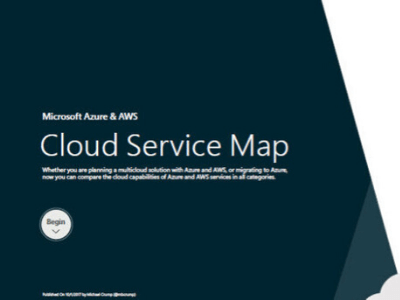
Microsoft just announced the release of a Cloud Service Map, which would help compare the cloud capabilities of Azure and AWS services in all categories.
You can download this Cloud Service Map from here: Cloud Service Map For AWS and Azure
The release of this Cloud Service Map would be particularly helpful for Microsoft and its partners to pitch/sell Azure to their potential customers, especially where AWS is also competing and already has preferable customer mindshare. Absence of such a resource has hurt Microsoft Cloud business in the past, and also caused a lot of confusion for potential customers, who were not well exposed to Microsoft Azure offerings. This would also help customers make informed decisions based on comparing services offerings from both players, and pick the right set for themselves.
The Cloud Service Map is broken out into 13 sections to make navigation between each service simple, according to the official announcement:
Marketplace – Cloud marketplace services bring together native and partner service offerings to a single place, making it easier for customers and partners to understand what they can do.
Compute – Compute commonly refers to the collection of cloud computing resources that your application can run on.
Storage – Storage services offer durable, highly-available, and massively-scalable cloud storage for your application, whether it runs in the cloud or not.
Networking & Content Delivery – Allows you to easily provision private networks, connect your cloud application to your on-premises datacenters, and more.
Database – Database services refers to options for storing data, whether it’s a managed relational SQL database that’s globally distributed or multi-model NoSQL databases designed for any scale.
Analytics and big data – make the most informed decision possible by analyzing all of the data you need in real-time.
Intelligence – Intelligence services enable natural and contextual interaction within your applications, using machine learning and artificial intelligence capabilities that include text, speech, vision, and search.
Internet of Things (IoT) – Internet of Things (IoT) services connect your devices, assets, and sensors to collect and analyze untapped data.
Management & monitoring – Management and monitoring services provide visibility into the health, performance, and utilization of your applications, workloads, and infrastructure.
Mobile services – Mobile services enable you to reach and engage your customers everywhere, on every device. DevOps services make it easier to bring a higher quality app to market faster, and a number of engagement services make it easier to deliver performant experiences that feel tailored to each user.
Security, identity, and access – A range of capabilities that protect your services and data in the cloud, while also enabling you to extend your existing user accounts and identities, or provisioning entirely new ones.
Developer tools – Developer tools empower you to quickly build, debug, deploy, diagnose, and manage multi-platform, scalable apps and services.
Enterprise integration – Enterprise integration makes it easier to build and manage B2B workflows that integrate with third-party software-as-a-service apps, on-premises apps, and custom apps.
The guidance is laid out in a table format that lets easily locate and learn more about each service one is most interested in.
Hope you found this blog post useful. If you have any queries/feedback, please feel free to mention it in the comments section below.

